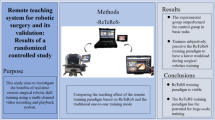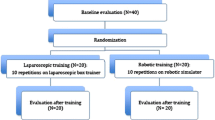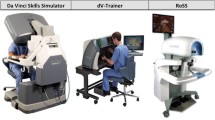Abstract
Purpose
To determine the impact of communication latency on telesurgical performance using the robotic simulator dV-Trainer\(^{\textregistered }\)
Methods
Surgeons were enrolled during three robotic congresses. They were randomly assigned to a delay group (ranging from 100 to 1000 ms). Each group performed three times a set of four exercises on the simulator: the first attempt without delay (Base) and the last two attempts with delay (Warm-up and Test). The impact of different levels of latency was evaluated.
Results
Thirty-seven surgeons were involved. The different latency groups achieved similar baseline performance with a mean task completion time of 207.2 s (\(p>0.05\)). In the Test stage, the task duration increased gradually from 156.4 to 310.7 s as latency increased from 100 to 500 ms. In separate groups, the task duration deteriorated from Base for latency stages at delays \(\ge \)300 ms, and the errors increased at 500 ms and above (\(p\,<\) 0.05). The subjects’ performance tended to improve from the Warm-up to the Test period. Few subjects completed the tasks with a delay higher than 700 ms.
Conclusion
Gradually increasing latency has a growing impact on performances. Measurable deterioration of performance begins at 300 ms. Delays higher than 700 ms are difficult to manage especially in more complex tasks. Surgeons showed the potential to adapt to delay and may be trained to improve their telesurgical performance at lower-latency levels.







Similar content being viewed by others
Abbreviations
- ATM line:
-
Asynchronous transfer mode line
- ms:
-
Millisecond
- PB1:
-
Peg-Board 1
- CT2:
-
Camera Targeting 2
- TR1:
-
Thread the Ring 1
- ED1:
-
Energy Dissection 1
References
Lanfranco AR, Castellanos AE, Desai JP, Meyers WC (2004) Robotic surgery: a current perspective. Ann Surg 239:14–21. doi:10.1097/01.sla.0000103020.19595.7d
Kim SP, Boorjian SA, Shah ND, Weight CJ, Tilburt JC, Han LC, Thompson RH, Trinh QD, Sun M, Moriarty JP, Karnes RJ (2013) Disparities in access to hospitals with robotic surgery for patients with prostate cancer undergoing radical prostatectomy. J Urol 189:514–520. doi:10.1016/j.juro.2012.09.033
Ghani KR, Sukumar S, Sammon JD, Rogers CG, Trinh QD, Menon M (2014) Practice patterns and outcomes of open and minimally invasive partial nephrectomy since the introduction of robotic partial nephrectomy: results from the nationwide inpatient sample. J Urol 191:907–912. doi:10.1016/j.juro.2013.10.099
Haidegger T, Sándor J, Benyó Z (2011) Surgery in space: the future of robotic telesurgery. Surg Endosc 25:681–690. doi:10.1007/s00464-010-1243-3
Gambadauro P, Torrejón R (2013) The “tele” factor in surgery today and tomorrow: implications for surgical training and education. Surg Today 43:115–122. doi:10.1007/s00595-012-0267-9
Marescaux J, Leroy J, Gagner M, Rubino F, Mutter D, Vix M, Butner SE, Smith MK (2001) Transatlantic robot-assisted telesurgery. Nature 413:379–380. doi:10.1038/35096636
Anvari M, McKinley C, Stein H (2005) Establishment of the world’s first telerobotic remote surgical service: for provision of advanced laparoscopic surgery in a rural community. Ann Surg 241:460–464
Anvari M (2007) Telesurgery: remote knowledge translation in clinical surgery. World J Surg 31:1545–1550. doi:10.1007/s00268-007-9076-5
Rayman R, Croome K, Galbraith N, CcCulure R, Morady R, Peterson S, Smith S, Subotic V, Van Wynsberghe A, Primak S (2006) Long-distance robotic telesurgery: a feasibility study for care in remote environments. Int J Med Robot Comput Assist Surg MRCAS 2:216–224. doi:10.1002/rcs.99
Rayman R, Croome K, Galbraith N, CcCulure R, Morady R, Peterson S, Smith S, Subotic V, Van Wynsberghe A, Pate R, Primak S (2007) Robotic telesurgery: a real-world comparison of ground- and satellite-based internet performance. Int J Med Robot 3:111–116. doi:10.1002/rcs.133
Sterbis JR, Hanly EJ, Herman BC, Marohn MR, Broderick TJ, Shih SP, Harnett B, Doarn C, Schenkman NS (2008) Transcontinental telesurgical nephrectomy using the da Vinci robot in a porcine model. Urology 71:971–973. doi:10.1016/j.urology.2007.11.027
Xu S, Perez M, Yang K, Perrenot C, Felblinger J, Hubert J (2014) Determination of the latency effects on surgical performance and the acceptable latency levels in telesurgery using the dV-Trainer\(^{({\textregistered })}\) simulator. Surg Endosc. doi:10.1007/s00464-014-3504-z
Lee JY, Mucksavage P, Kerbl DC, Huynh VB, EtafyM Mc, Dougall EM (2012) Validation study of a virtual reality robotic simulator-role as an assessment tool? J Urol 187:998–1002. doi:10.1016/j.juro.2011.10.160
Perrenot C, Perez M, Tran N, Jehl JP, Felblinger J, Bresler L, Hubert J (2012) The virtual reality simulator dV-Trainer\(^{({\textregistered })}\) is a valid assessment tool for robotic surgical skills. Surg Endosc 26:2587–2593. doi:10.1007/s00464-012-2237-0
Ruparel RK, Taylor AS, Patel J, Patel V, Heckman MG, Rawal B, Leveillee RJ, Thiel DD (2014) Assessment of virtual reality robotic simulation performance by urology resident trainees. J Surg Educ 71:302–308. doi:10.1016/j.jsurg.2013.09.009
Rosser JC Jr, Gabriel N, Herman B, Murayama M (2001) Telementoring and teleproctoring. World J Surg 25:1438–1448
Lendvay TS, Hannaford B, Satava RM (2013) Future of robotic surgery. Cancer J Sudbury Mass 19:109–119. doi:10.1097/PPO.0b013e31828bf822
Nguan CY, Morady R, Wang C, Harrison D, Browning D, Rayman R, Luke PPW (2008) Robotic pyeloplasty using internet protocol and satellite network-based telesurgery. Int J Med Robot 4:10–14. doi:10.1002/rcs.173
Author information
Authors and Affiliations
Corresponding author
Ethics declarations
Conflict of interest
The authors Manuela Perez, Song Xu, Sanket Chauhan, Alyssa Tanaka, Khara Simpson, Haidar Abdul-Muhsin and Roger Smith declare they have no disclosure or conflict of interest to declare
Additional information
Grant Information: Funding Source: U.S. Army Telemedicine and Advanced Technology Research Center. Grant #: W81XWH-11-2-0158. The Grant was provided to the Florida Hospital Nicholson Center without personal benefit for the authors.
Rights and permissions
About this article
Cite this article
Perez, M., Xu, S., Chauhan, S. et al. Impact of delay on telesurgical performance: study on the robotic simulator dV-Trainer. Int J CARS 11, 581–587 (2016). https://doi.org/10.1007/s11548-015-1306-y
Received:
Accepted:
Published:
Issue Date:
DOI: https://doi.org/10.1007/s11548-015-1306-y




